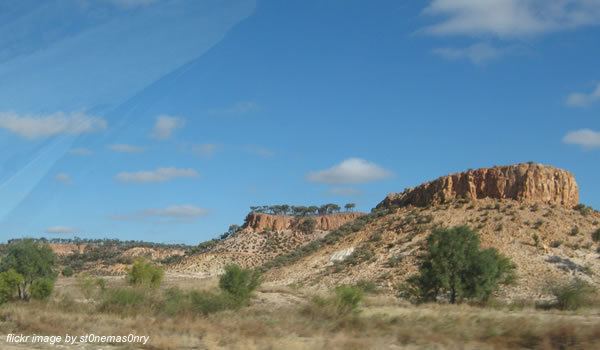Population 2,796 (2011 census) Mean max temp Mean min temp Postal code 4824 | Postcode(s) 4824 Elevation 186 m Local time Tuesday 10:15 PM | |
 | ||
Location 1,707 km (1,061 mi) NW of Brisbane783 km (487 mi) W of Townsville121 km (75 mi) E of Mount Isa Weather 27°C, Wind S at 24 km/h, 75% Humidity Points of interest Cloncurry Mary Kathleen, Corella Dam, Overlanders Way, Clem Walton Park, Mary Kathleen Mine | ||
Cloncurry is a town and locality in the Shire of Cloncurry, Queensland, Australia. It is the administrative centre of the shire. In the 2011 census, Cloncurry had a population of 2,796 people.
Contents
- Map of Cloncurry QLD 4824 Australia
- Geography
- History
- Heritage listings
- Climate
- Notable residents
- Facilities
- Education
- Transport
- References
Map of Cloncurry QLD 4824, Australia
Cloncurry is known as the Friendly Heart of the Great North West and will celebrate its 150th anniversary in 2017.
Geography
Cloncurry is situated in the north-west of Queensland, 770 kilometres west of the city of Townsville via the Flinders Highway. The town lies adjacent to the Cloncurry River.
Cattle grazing is the significant industry in the region, and a large sale yards is located in the town.
History
The first Europeans to traverse the area were Burke and Wills on their epic, and ultimately fatal, transcontinental expedition. The Cloncurry River was named by Burke after Lady Elizabeth Cloncurry, his cousin, with the town eventually taking its name from the river.
Ernest Henry discovered copper in the area in 1867, and the town sprang up to service the Great Australia Mine to the south. Roger Sheaffe established the first pastoral run in the Cloncurry district - "Fort Constantine". Gold was discovered at Top Camp. The town was surveyed in 1876. Cloncurry was proclaimed a town in 1884.
The Cloncurry Advocate was a newspaper published in Cloncurry between 1889 and 1953.
Queensland's Northern Line railway reached Cloncurry in December 1907 and was officially opened the next year.
In 1914 a fire broke out in the town resulting in the destruction of the Post Office, the hotel, eleven shops, two store-rooms and a cottage. The telegraph office was saved by employees who kept the office damp and protected with wet blankets. One man died in the blaze which cost an estimated £15,000.
The discovery of uranium at Mary Kathleen brought wealth to the community in the 1950s. Until the development of Mount Isa in the 1960s, Cloncurry was the administrative centre of the region.
The first ever flight of the Royal Flying Doctor Service of Australia took place from Cloncurry on 15 May 1928, using a de Havilland DH.50 aircraft hired from the then small airline, Qantas. A Royal Flying Doctor Service museum is situated in the town.
The population in Cloncurry decreased from 3,898 in 1996 to 2,900 in 2002.
At the 2006 census, the town had a population of 2,384.
Heritage listings
Cloncurry has a number of heritage-listed sites, including:
Climate
Cloncurry was widely regarded as holding the record for the highest temperature recorded in Australia at 53.1 °C (127.5 °F) on 16 January 1889. Recent investigations have revealed that this temperature was measured in an improvised screen made from a beer crate and that it equated to 47–49 °C under standard conditions. The highest temperature ever recorded at Cloncurry's current weather station is 46.9 °C (116.4 °F), well short of the now widely disputed 1889 temperature of 53.1 °C. The average annual rainfall is 584.5 mm (23.0 in), almost all of which falls between the months of December to March
Because of the area's extreme solar conditions, Cloncurry was expected to become Australia's first solar-powered town. However the planned 10MW Thermal solar plant was scrapped due to light pollution concerns and a 2.128MW flat panel photovoltaic solar farm was to be built in its place. However, the Queensland Government withdrew financial support for the solar farm in May, 2012.
Notable residents
Facilities
Cloncurry has a public library, gallery, public swimming pool, showground, racecourse, Flying Doctor museum and a mineral display in the old post office.
Education
Cloncurry State School (opened on 19 March 1884) is a government co-educational Prep to Year 12 School at Daintree St., Cloncurry. In 2015 the School had 281 students enrolled with a teaching staff of 28 FTE (Full time equivalent) and 15 FTE (Full time equivalent) non teaching staff. The general population in the community is highly transient with approximately 40% turnover in student enrolment in 2015. Approximately 60% of student enrolment identify as Aboriginal and or Torres Strait Islander.
Transport
Cloncurry has linkages to other destinations via major coach operators such as Greyhound and Bus Queensland. A weekday service to Mount Isa is operated by Cloncurry Coaches as well as local charter services within the area for mining, school, sporting bodies and special events.
